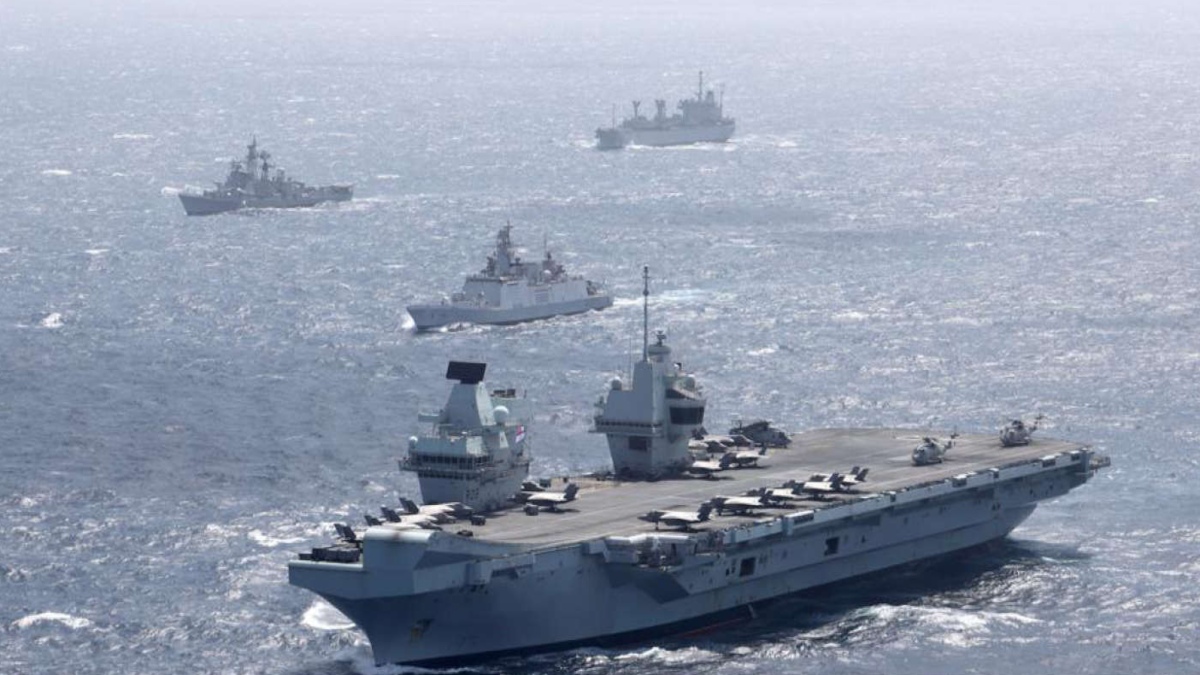


Indian Navy participated in a three-day bilateral Passage Exercise (PASSEX) with Royal Navy Carrier Strike Group (CSG)-21 led by HMS Queen Elizabeth in the Bay of Bengal from 21st to 23rd July. The bilateral Maritime Exercise was designed to hone the ability of the two navies to operate together in the maritime domain. The maiden exercise between Indian Navy and the Royal Navy’s latest Aircraft Carrier, HMS Queen Elizabeth included participation of CSG-21 comprising Type 23 Frigates and an Astute-class submarine in addition to the other surface combatants. Indian Navy was represented by IN Ships Satpura, Ranvir, Jyoti, Kavaratti, Kulish and a submarine. Anti-Submarine Warfare capable Long Range Maritime Reconnaissance Aircraft P8I also participated in the exercise.



With the presence of the CSG-21 in the Indian Ocean, the ongoing exercise has afforded excellent opportunity to engage over the entire spectrum of maritime operations including ASW, Anti-Air and Anti-Surface warfare. The exercise also witnessed the maiden participation of the F 35 B Lightning which operate from the deck of HMS Queen Elizabeth. Regular IN-RN interactions over the years have augmented their professional content, interoperability and adaptability in the ever-changing security scenarios. The inter-operability achieved over the years has ensured a quantum jump in the complexity and scale of professional exchanges which is being further enhanced by the presence of the Royal Navy’s Carrier Strike Group in the Indian Ocean.
Both the UK and India are in the midst of a carrier renaissance, with the CSG spearheading the UK’s Joint Expeditionary capability. The joint endeavour provides tangible security to friends and a credible deterrence to those who seek to undermine global security. An Indian warship will also exercise with the Royal Navy off the coast of the UK in August. First Sea Lord, Admiral Sir Tony Radakin said, “This is a month that will see the Royal Navy and Indian Navy meet and work together in two oceans – beginning in the Indian Ocean as the UK Carrier Strike Group arrives for the first of multiple UK-India exercises and events. Later this summer, both will participate in a separate exercise in the Atlantic Ocean. The deployment is proof of the strength, energy and significance of the growing relationship between our navies.”Chief of Joint Operations, Vice Admiral Sir Ben Key said, “The UK and India are key defence partners and the Carrier Strike Group’s deployment is a symbol of Global Britain in action, showcasing our commitment to India, the Indo-Pacific region, and confronting threats to international order.”Commodore Steve Moorhouse, Commander United Kingdom Carrier Strike Group, mentioned, “As HMS Queen Elizabeth and her Carrier Strike Group cross the Indian Ocean, it is only natural that we should exercise with the Indian Navy. At the strategic level, the exercise is a muscular expression of the closer defence partnership that Prime Ministers Johnson and Modi envisaged when they agreed the UK-India Roadmap 2030 earlier this year.”
As part of its maiden operational deployment, the CSG will sail over 26,000 nautical miles, engaging with 40 countries from the Mediterranean to the Indo-Pacific and back again. The fifth generation HMS Queen Elizabeth carrier, at 65,000 tonnes, is the largest surface vessel ever constructed in the UK. Taller than Niagara Falls, her propellers generate the power of 50 high-speed trains. She leads six Royal Navy ships, a Royal Navy submarine, a US Navy destroyer and a frigate from the Netherlands in the largest concentration of maritime and air power to leave the UK in a generation. It is equipped with the fifth generation F-35B Lightning multi-role aircrafts. They are being jointly crewed by the Royal Air Force, Royal Navy and the US Marine Corps. From defending democratic values and tackling shared threats, to seizing new trade opportunities through engagements with Singapore, the Republic of Korea, Japan, India and others, the deployment marks a step-change in UK engagement in the region. The UK is already investing significantly in the region by seeking ASEAN Dialogue Partner status, kicking off negotiations to join the Comprehensive and Progressive Agreement for Trans-Pacific Partnership (CPTPP) and rapidly progressing trade talks with Australia, New Zealand and India.